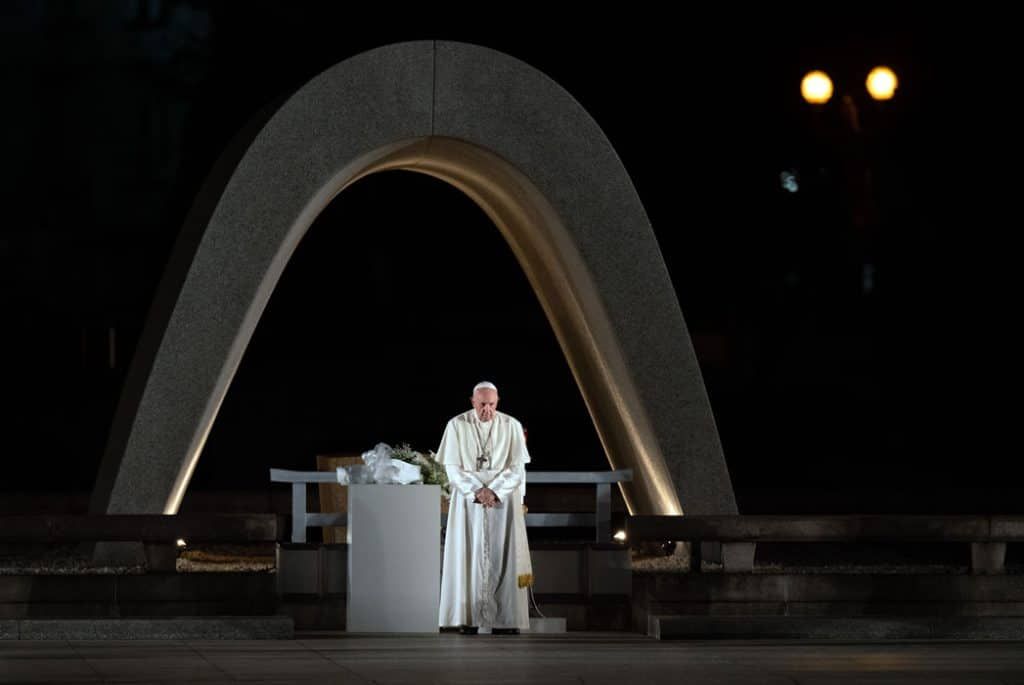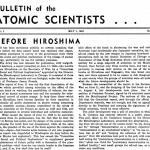A message from Hiroshima on the reality of the atomic bombing
By Hidehiko Yuzaki | August 5, 2020
 Pope Francis in Hiroshima in November 2019, when he said nuclear weapons are immoral for war—and even for deterrence. (Photo by Carl Court/Getty Images)
Pope Francis in Hiroshima in November 2019, when he said nuclear weapons are immoral for war—and even for deterrence. (Photo by Carl Court/Getty Images)
On August 6, 75 years ago, an atomic bomb was dropped on Hiroshima, the first such event ever in the history of mankind. The bomb exploded in midair over the city, emitting a flash of scorching light, blast, and radiation, which instantly claimed many precious lives and devastated the survivors in many ways, some of those effects lasting till now.
Even today, beneath the city’s streets and in the city’s rivers, there remain traces of many innocent citizens who were reduced to mere ashes in a moment, their spirits filled with indignation.
Although some survived against all odds, the young ones were deprived of their fathers, mothers, brothers, or sisters, leading them to live as orphans. Many lost their homes after the war, appropriated for the sake of the restoration of the city, and people suffered discrimination, like salt being rubbed into their wounds. The victims still suffer today from disease caused by their exposure to the radiation and remain threatened by the shadow of the atomic bombing. Many A-bomb victims are forced to struggle with indescribable hardships which they never would have had to endure if it had not been for the atomic bombing. Seventy-five years after the catastrophe, the predicament experienced by these victims, rather than being part of the past, continues.
Many A-bomb survivors in fact are extremely reluctant to talk about their terrible memories. Still, they have long been working as storytellers at the cost of their emotional pain, sharing with other people the indescribably inhumane experiences that they went through in Hiroshima and Nagasaki, with a desperate sense of responsibility to provide lessons for mankind.
Why, then, has the urge of these victims and of the cities of Hiroshima and Nagasaki for the abolition of nuclear weapons been betrayed for such a long time?
The situation surrounding nuclear weapons. There are still more than 13,000 nuclear weapons in the world, with the nuclear weapon countries continuing to modernize their nuclear forces. Today, as nuclear disarmament continues to stagnate, the situation concerning the elimination of nuclear weapons is extremely bleak. This is indicated by the lapse of the Intermediate-Range Nuclear Forces (INF) Treaty; the United States’ unilateral withdrawal from the Iran nuclear deal, officially known as the Joint Comprehensive Plan of Action (JCPOA); Iran’s suspension of the fulfillment of some of the JCPOA requirements; and the issue of the extension of the New Strategic Arms Reduction Treaty (START), which is scheduled to expire next year.
The need to defeat nuclear deterrence theory. Even though no country formally opposes the goal of abolishing nuclear weapons, no practical progress has been recently seen in nuclear disarmament. To ensure that nations are seriously committed to the elimination of nuclear weapons, discrediting the enigmatic nuclear deterrence theory—the primary rationale for the reliance on nuclear weapons—is of vital importance.
While tensions are increasing in Northeast Asia and South Asia, no adequate scrutiny seems to have been conducted during the long period of time after the end of the Cold War to confirm whether the assumptions underpinning deterrence theory fit the reality of the world.
To clarify this point, render the nuclear deterrence theory obsolete, and establish a theoretical path toward the abolishment of nuclear weapons, Hiroshima is working on joint research to hammer out measures for substantive nuclear disarmament. We have concluded partnership agreements with peace research institutions worldwide, such as the United Nations Institute for Disarmament Research (UNIDIR), the Stockholm International Peace Research Institute (SIPRI), and the Royal Institute of International Affairs.
These efforts are making it clear that significant issues exist regarding nuclear deterrence in the following four aspects: the assumptions underpinning the implementation of nuclear deterrence; the perpetual value of extended deterrence; influence from the emergence of new technologies; and the blurred boundary between conventional weapons and nuclear weapons.
First, nuclear deterrence theory was formed at a time of increasing tension between the United States and the Soviet Union and based on the polarized political structure of the world; it has been underpinned mainly by the assumptions that states are rational entities, in which decision-makers make rational choices, and that reducing the incentive for pre-emptive attack ensures strategic stability. Today, however, we are aware that decision-making processes are affected by the decision makers’ personal experiences, values, and biases, and that technological progress can generate incentives for the use or threat of the use of nuclear weapons.
The recent uncertainty concerning the US commitment to NATO and other alliance partners is stirring distrust of the United States, raising concern about extended deterrence. In addition, there have been developments in automation and the introduction of artificial intelligence in the field of nuclear weapons, as well as the impact of these new technologies on decision-making processes. Moreover, some missile defense systems are vulnerable to new weapons such as hypersonic glide vehicles and cruise missiles. As a result, there are indications that it might be possible to defeat the deterrence theory.
Considering their huge destructive power, nuclear weapons have been treated so far as extraordinary weapons by most countries. Lately, however, some officials and scholars assert that the impact of the use of low-yield nuclear weapons should not be totally distinguished from that of conventional, large-scale attacks. Backed by this assertion, nuclear powers are now competing in their efforts to upgrade and improve their nuclear weapons and are even trying to reach the point of developing “usable” nuclear weapons.
Nuclear deterrence theory is based on truly uncertain assumptions, with technological innovation and geopolitical factors bringing into question any future prospect that deterrence will continue to prevent nuclear war. In these circumstances, we must never allow ourselves to stop thinking critically or to depend on nuclear deterrence theory without any doubts.
Establishment of a new security theory. Nuclear deterrence theory—that is, deterring attack from enemies by possessing nuclear weapons—is merely an idea, or a fiction, shared and believed by people. It is nothing like the undeniable laws of the universe and can even be considered as utterly groundless, as the analysis above shows.
Meanwhile, the destructive power of nuclear weapons—as described by Einstein and other nuclear physicists—belongs to the undeniable laws of the universe. Once a nuclear weapon detonates, nothing can escape from the energy unleashed. Accordingly, the only way based on the law of the universe to stay safe from such energy is to ensure that nuclear weapons never explode—by physically eliminating them, and not by believing the fiction that the enemy will not use them.
Fortunately, since nuclear deterrence theory is a fiction that people share with one another, it will lose its effectiveness if everybody stops believing in it. In other words, people can change the theory. As with the case of the deplorable system of slavery, which was widely believed to be acceptable but is now absolutely unacceptable, the national security system relying on nuclear weapons can be changed, because nuclear deterrence theory is in fact a common myth created and shared by people.
Agreement on the UN target of the abolition of nuclear weapons. Everyone on Earth is a stakeholder in this persistent issue. We need to generate powerful momentum toward the abolishment of nuclear weapons by invoking the engagement of as many people as possible and networking them.
To do so, it is imperative to bring the discussions on the elimination of nuclear weapons from within the community of specialists on disarmament and security to an ever more extensive range of stakeholders. The issue of nuclear weapons is a clear and present risk to mankind, in line with other global issues such as global warming, communicable diseases, and the fair and sustainable development of the developing nations, all of which require ardent and urgent attention of international communities to form a consensus.
The disarmament agenda drawn up by UN Secretary-General António Guterres comprehensively describes the disarmament challenges that international society faces today, including as regards to nuclear weapons. To fulfill this agenda steadily, it is necessary to facilitate discussion, involving all UN members, international governmental organizations, and nongovernmental organizations.
Through these measures, Hiroshima will strive to help all UN members agree to eliminate nuclear weapons as soon as possible and set their elimination as a new target.
Determination to realize the abolishment of nuclear weapons. As Pope Francis suggested in Hiroshima, mankind’s departure from nuclear deterrence theory requires wisdom collected from all over the world and actions taken by all countries and all people.
Regrettably, the elimination of nuclear weapons could not be accomplished during the past 75 years, once described as the period when no plants would grow. We must take this fact seriously and renew our pledge to abolish nuclear weapons as soon as possible while A-bomb victims are still alive. (The average age of A-bomb survivors is 83.)
So let us share wisdom and take actions now, before future generations blame us for our inaction and irresponsibility.
Together, we make the world safer.
The Bulletin elevates expert voices above the noise. But as an independent nonprofit organization, our operations depend on the support of readers like you. Help us continue to deliver quality journalism that holds leaders accountable. Your support of our work at any level is important. In return, we promise our coverage will be understandable, influential, vigilant, solution-oriented, and fair-minded. Together we can make a difference.
Keywords: Hiroshima, Nagasaki, nuclear abolition, nuclear deterrence, nuclear disarmament
Topics: Hiroshima & Nagasaki, Nuclear Weapons
Share: [addthis tool="addthis_inline_share_toolbox"]















One aspect of the two atomic bombs is the fission products that were likely spread over a fairly wide area. Primaries, daughters, granddaughters with half lives exceeding 10 years should be detectible.